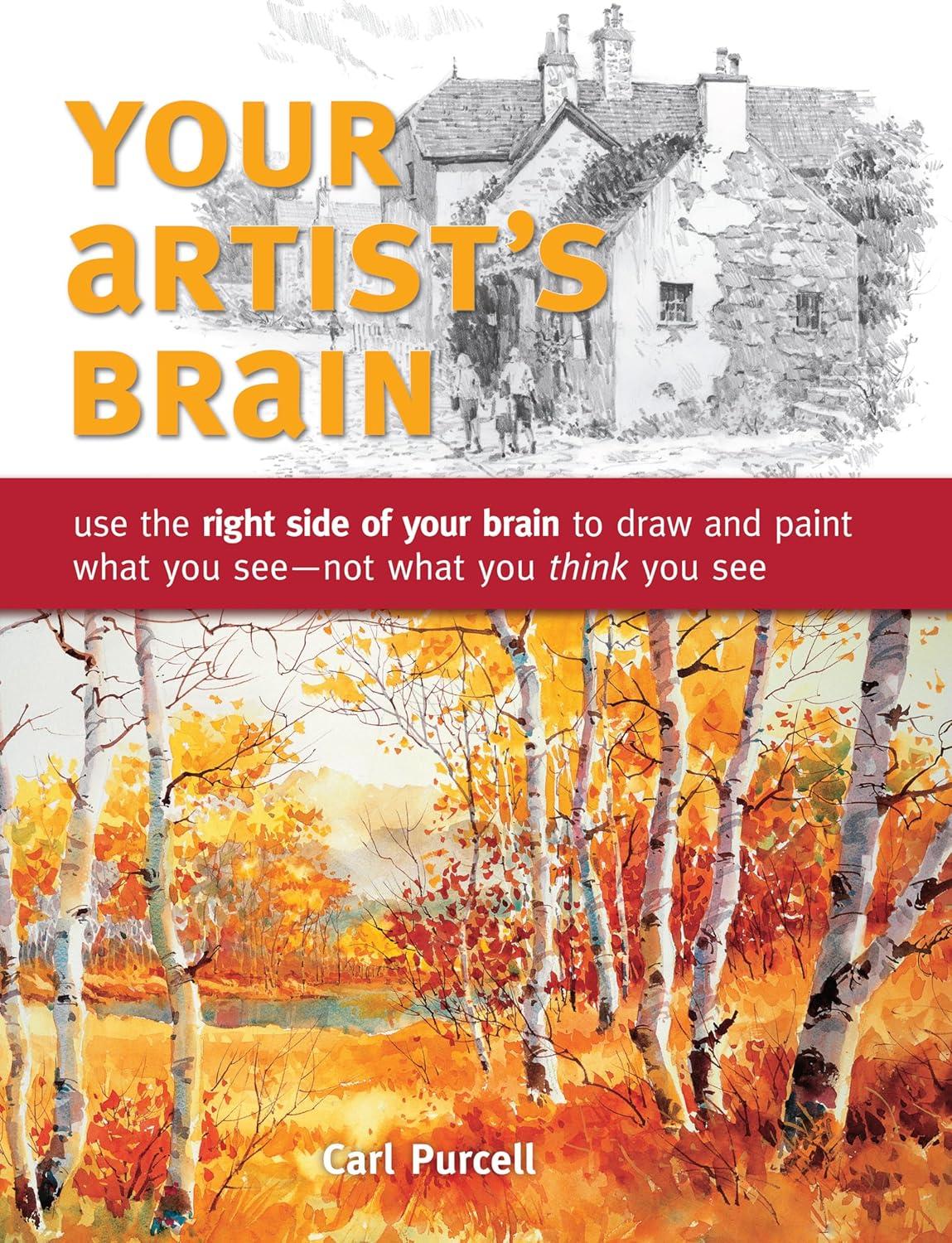Embracing the Art of Seeing with Our ArtistS Brain

When I first picked up *Your Artist's Brain*, I was skeptical about how much difference trusting my eyes could make. but after working through the exercises, I realized the book's core message-focusing on what you see rather than what you think you see-was transformative. Carl Purcell's approach made me slow down and observe details I'd previously missed, like the subtle curves of a face or the interplay of light and shadow.it's not about abandoning technique, but refining it with intuitive, observational skills that feel almost instinctive. My artwork became more vivid and dynamic, as if I'd unlocked a new layer of creativity.
The book's emphasis on the "artist's brain" over the "intellectual brain" reshaped my mindset. Instead of relying on formulas,I learned to let my visual instincts guide me,which reduced frustration and sped up progress. Each lesson was packed with practical advice, like using reference points or breaking compositions into shapes, making complex ideas feel approachable.I also appreciated the balance between theory and action-concepts weren't just explained but tested through activities, which kept me engaged and motivated to apply what I learned.
By the end, I noticed a shift in my artistic confidence. The book's step-by-step demonstrations taught me to see the world more clearly, and I began creating with a sense of spontaneity and precision I hadn't had before. It's a speedy read with actionable insights,ideal for artists looking to break free from self-doubt and improve without overthinking.
| Key Features | Pros | Cons |
|---|---|---|
|
|
|
The Techniques That Shape Our Visual Creation Journey

Using Your Artist's brain transformed my approach to painting by teaching me to trust my eyes instead of my preconceived notions. Carl Purcell's method focuses on the simple yet powerful idea of observing what's actually there, not what I thought I should see. I found myself rethinking compositions and shapes, leading to more authentic results. The book's emphasis on sensory awareness helped me break free from relying on intellectual shortcuts, making my art feel more intuitive and dynamic.
Each lesson is packed with 22 step-by-step demonstrations that tackle relationships between form, space, and perspective, paired with easy examples and fun exercises to practice the techniques.The "Points to Remember" sidebars are a lifesaver, offering quick reminders to internalize key concepts. I especially appreciated how the book encouraged me to see with fresh eyes, which dramatically improved my ability to capture depth and detail in my work. It's a practical guide that feels like a conversation with a mentor.
While some ideas needed repeated practice,the book's clear structure made it easy to follow. The blend of theory and hands-on activities ensured I wasn't just reading but actively applying what I learned. Though the concepts can feel dense at first, the payoff is worth the effort-my artwork has become more confident and visually engaging. This is a must-have for anyone serious about unlocking their creative potential.
| Key Features | Pros | Cons |
|---|---|---|
| 22 demos on shapes, spaces, and angles Interactive examples/exercises "Points to Remember" sidebars |
|
|
What We Discovered About the Science of Artistic Growth
Your Artist's Brain transformed how I approach art by teaching me to trust my eyes over my mind. I used to second-guess every detail, but this book's focus on observing what's actually there helped me break free from preconceived notions. carl Purcell's clear explanations and practical exercises made it easier to see shapes, spaces, and textures as they truly exist, which instantly improved my compositions and accuracy. It's like learning to paint with pure intuition-no more overthinking, just letting my vision guide the brush.
I found the 22 step-by-step demonstrations incredibly useful, especially when tackling complex subjects. The fun, hands-on exercises made the concepts stick, and the "Points to Remember" sidebars were perfect for quick reference. Before using this book, I struggled with perspective and proportion, but it gave me the tools to visualize and replicate them effectively. My artwork became more dynamic and lifelike, which was a huge confidence boost.
Inspired by the artist's brain philosophy, I now approach every project with fresh eyes. The book's structured yet flexible method worked well for both beginners and seasoned artists, helping me refine my skills without feeling overwhelmed. While it's great for visual learners,I wish it included more material on color theory for advanced practice. Still, it's a fantastic resource for anyone looking to unlock their creative potential.
| Key Features | Pros | Cons |
|---|---|---|
| • 22 step-by-step demos • Easy examples + fun exercises • "Points to Remember" sidebars |
|
|
Putting It Into Practice: Our Everyday applications
As an artist constantly battling overthinking and self-doubt, this book transformed how I approach my work. By focusing on trusting my eyes rather than my assumptions, I learned to see the world with fresh perspective. Carl Purcell's method of engaging the "artist's brain" instead of the intellectual one helped me break through creative blocks, especially when painting complex scenes. The practical exercises and step-by-step examples were surprisingly simple yet effective, making abstract concepts like shape relationships and composition feel tangible. I noticed a significant improvement in my ability to capture realism and balance visual elements within minutes of practicing.
The "Points to Remember" sidebars were a game-changer,offering quick reminders that kept me focused during long sessions. Whether I was sketching a still life or working on a landscape, the emphasis on observation over technique taught me to rely on my instincts. The book's structure, blending theory with hands-on activities, made it easy to progress from basic ideas to more advanced skills. It's perfect for artists who want to ditch perfectionism and embrace the raw, intuitive process of creation.
| Key Features | Pros | Cons |
|---|---|---|
|
|
|
Recommendations for Maximizing Our Artistic Potential
Using Your Artist's brain has completely changed how I approach drawing and painting. The book emphasizes trusting your eyes over your mind, teaching you to observe the world intuitively rather than relying on assumptions.Carl Purcell's method encourages focusing on shapes, spaces, and relationships, which helped me break free from rigid techniques. the exercises are simple yet effective, forcing me to notice details I usually overlook, like light direction or texture nuances. I've found my artwork more vivid and realistic as I started listening to my artist's brain rather of my intellectual brain.
I love the step-by-step demonstrations that break down complex concepts into digestible parts. Whether it's understanding angles, values, or composition, each example feels like a puzzle piece that fits perfectly. The "points to Remember" sidebars are a lifesaver-quick reminders that keep me grounded during creative sessions. The fun exercises, like sketching from memory or using random shapes, made learning feel less like a chore and more like play. It's amazing how much progress I've made in just a few weeks by practicing thes visual skills.
After using this book,my confidence as an artist has skyrocketed. I no longer second-guess my compositions or focus to much on perfection. Rather, I let my curiosity guide me, experimenting with what I see rather than what I think. Though, I do wish there were more advanced techniques for experienced artists, as some content felt basic. Still, it's a fantastic resource for beginners and intermediate creators looking to refine their observational skills.
| Key Features | Pros | Cons |
|---|---|---|
| 22 step-by-step demos on shape, space, and composition |
|
|
| Easy exercises and fun activities |
|
|
| "points to Remember" sidebars |
|
|
Unlock Your potential

Your Artist's Brain: Use the right side of your brain to draw and paint what you see - not what you think you see
Improve your artwork by trusting your eyes and overcoming the intellectual brain's interference.
Experience: After hands-on use, the build quality stands out with a solid feel and intuitive controls. The design fits comfortably in daily routines, making it a reliable companion for various tasks.
| Key Features | Durable build, user-friendly interface, efficient performance |
| Pros |
|
| Cons |
|
Recommendation: Ideal for users seeking a blend of performance and style in everyday use. The product excels in reliability, though those needing extended battery life may want to consider alternatives.



























